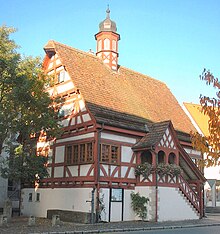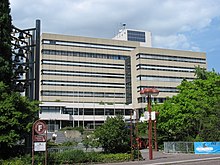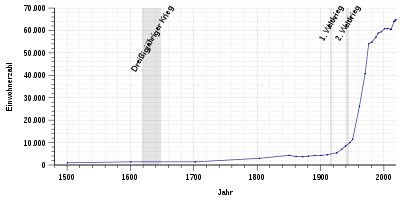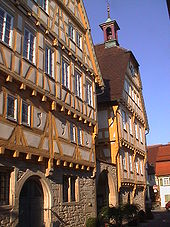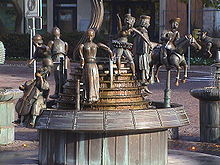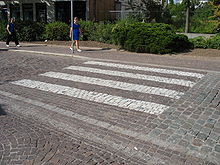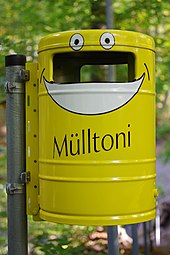Sindelfingen
| coat of arms | Germany map | |
|---|---|---|

|
Coordinates: 48 ° 43 ' N , 9 ° 0' E |
|
| Basic data | ||
| State : | Baden-Württemberg | |
| Administrative region : | Stuttgart | |
| County : | Boeblingen | |
| Height : | 449 m above sea level NHN | |
| Area : | 50.85 km 2 | |
| Residents: | 64,858 (Dec. 31, 2018) | |
| Population density : | 1275 inhabitants per km 2 | |
| Postcodes : | 71063, 71065, 71067, 71069 | |
| Area code : | 07031 | |
| License plate : | BB, LEO | |
| Community key : | 08 1 15 045 | |
| LOCODE : | DE SDN | |
| City structure: | Core city and 2 districts | |
City administration address : |
Rathausplatz 1 71063 Sindelfingen |
|
| Website : | ||
| Lord Mayor : | Bernd Vöhringer ( CDU ) | |
| Location of the city of Sindelfingen in the Boeblingen district | ||
Sindelfingen is a large district town in the middle of the state of Baden-Württemberg , about 15 km southwest of Stuttgart . It is the largest city in the Böblingen district and, together with the neighboring city of Böblingen to the south, forms a central center for the surrounding communities.
Sindelfingen has been a major district town since February 1, 1962 .
geography
location
Sindelfingen is located outside the northeastern edge of the Upper Gäus , at the foot of some heights of the Glemswald ( landscape protection area ) between the Schwippe , which rises in the city, and the Sommerhofenbach. The highest point of the district is at 532, the lowest at 409 m above sea level. NN. The urban area extends from 425 to 460 m above sea level. NN. The northern Black Forest can be reached from Sindelfingen in about half an hour, the Swabian Alb in 50 minutes.
climate
The annual precipitation is 735 mm and is therefore comparatively normal, as it falls in the middle third of the values recorded in Germany. Lower values are registered at 48% of the German Weather Service's measuring stations . The driest month is January, with the most rainfall in June. In June there is 2.3 times more rainfall than in January. Precipitation varies greatly. Higher seasonal fluctuations are registered at only 15% of the measuring stations.
Neighboring communities
The following cities and municipalities border the city of Sindelfingen. Starting in a clockwise direction , they are named in the east: Stuttgart ( city district ), Leinfelden-Echterdingen ( district Esslingen ) as well as Böblingen , Ehningen , Aidlingen , Grafenau , Magstadt and Leonberg (all district Böblingen ).
City structure
Sindelfingen consists of the core city and the districts of Maichingen and Darmsheim, which were incorporated as part of the 1971 regional reform . Both incorporated former municipalities are localities within the meaning of the Baden-Württemberg municipal code , that is, they each have a local council , which is re-elected by the local population at each local election . The chairman of the local council is the mayor .
For several years now, the new Flugfeld district has been under construction on the area of the former Böblingen airfield , a joint project between the cities of Sindelfingen and Böblingen. Two thirds of the district will be on the Böblingen district, the remaining third on the Sindelfingen district. In Areal Forum 1, for example, the state agency INUTEC-BW (Innovation and Technology Center for Environmental Technology and Resource Efficiency GmbH) was opened in 2011. The entire construction period is planned until 2031 .
In the core city, a distinction is made between residential areas with their own names, the names of which have emerged in the course of history due to the development and which, however, are usually not exactly definable. These include, for example, Königsknoll, Viehweide, Eschenried, Pfarrwiesen, Rotbühl, Spitzholz, Eichholz, Hinterweil and Goldberg.
Spatial planning
Together with the neighboring town of Böblingen, Sindelfingen forms a medium-sized center within the Stuttgart region , the regional center of which is Stuttgart. In addition to the two cities, the central area Böblingen / Sindelfingen also includes the municipalities in the central part of the district of Böblingen, namely Aidlingen , Altdorf , Ehningen , Gärtringen , Grafenau , Hildrizhausen , Holzgerlingen , Magstadt , Schönaich , Steinenbronn , Waldenbuch and Weil im Schönbuch .
history
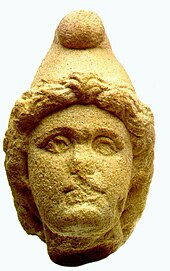
Prehistory and Antiquity
In the 4th millennium BC There was a Neolithic settlement in the Gewann Hinterweil. Also in the Urnfield , Hallstatt and Latène times there were isolated settlements in the city area, as shown by broken fragments, burial mounds and urn graves. In the 1st to 3rd centuries there was a Roman vicus (street village) on the northern slope of the Goldberg , next to which there were smaller manors spread across the area. Soon after the fall of the Limes in AD 260, the Alamanni settled here and founded the three villages of Sindelfingen, Altingen and Bochtelfingen on what is now the Sindelfingen core area.
middle Ages
A predecessor of today's Martinskirche with cemetery has stood in the area of an older manor house of the ancestors of the later Counts of Calw . In the Franconian period from the 8th to the 11th century, Sindelfingen was the center of a Franconian county that was subordinate to the later Counts of Calw, one of the most important noble families in today's Baden-Württemberg. According to the Sindelfingen annals written in the 13th century , Count Adalbert (II.) Atzinbart founded a Benedictine double monastery for monks and nuns in his Sindelfingen ancestral seat around 1050, which he soon moved to Hirsau to the Aurelius Monastery, which he had rebuilt, from which the world-famous reform monastery Hirsau emerged. Instead, he founded a canon monastery in Sindelfingen around 1065 , which was first mentioned in 1155 as "praepositura in Sindelvinga". For its construction, he demolished his ancestral seat with the older Martinskirche and moved his seat to Calw. There he built a new manor's castle and opened up a closed power territory through clearing work. The construction of the new Martinskirche in Sindelfingen proceeded only slowly; The crypt was consecrated in 1100 , but the actual church was not completed until 1132 by the Guelphs , who set up a mint in Sindelfingen . The Sindelfingen Canons' Monastery became rich and important over the next few centuries through further foundations, but in 1351 it came under the rule of the counts and later dukes of Württemberg . In 1476 they founded a new monastery in Tübingen, whose property formed the financial basis for the famous Eberhard Karls University . This new pen received most of the old Sindelfingen ownership. The Canons of Sindelfingen were the first professors and the provost Johannes Tegen their first chancellor. The following Augustinian Canons' Monastery was founded in Sindelfingen from what was left of the property and was finally dissolved by the Dukes of Württemberg in 1535 as part of the Reformation.
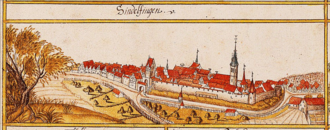
Around 1130 the village of Sindelfingen came into the possession of the Guelphs with his neighboring village Böblingen through Uta von Schauenburg , the heiress of Count Gottfried von Calw and wife of Duke Welfs . In the ensuing dispute over inheritance, the village of Sindelfingen was burned down in 1133 by Uta's cousin Adalbert IV von Calw . In the second half of the 12th century there was a Guelph mint in Sindelfingen; a pot with numerous silver bracteates from this workshop was discovered buried in the floor of St. Martin's Church in 1973. The transfer of ownership to the Count Palatine of Tübingen has not been fully clarified; it is likely to have taken place via the purchase of the possessions of Welf V by Emperor Friedrich Barbarossa and a subsequent enfeoff to the Tübingen Count Palatine. As part of inheritance divisions, the villages of the Sindelfingen district came into the possession of Count Rudolf the Scherer of Tübingen-Herrenberg , the village of Böblingen to his cousin, who founded a town there around 1250. As a reaction, the city of Sindelfingen was founded in 1263 between the monastery district and the village of Sindelfingen by Count Rudolf the Scherer; the villages of Sindelfingen, Altingen and Bochtelfingen later merged into the new city. In 1274 King Rudolph wrote that Sindelfingen should enjoy the same freedom as Tübingen. Even before the city wall was completed, the Böblinger attacked the city of Sindelfingen. Since then, there has been a pronounced rivalry between the two neighboring cities.
Württemberg time
In 1351 the city was sold to Württemberg . The new masters introduced the Reformation in 1535 . For a long time, Sindelfingen remained an insignificant country town that could never come to terms with belonging to the Böblingen district within the Duchy of Württemberg and subordinate to the neighboring town. In 1607 the citizens of Sindelfingen finally managed, through an extraordinary tax payment to the duke, to be detached from this upper office and to become an official city independent of Böblingen without its own offices. This privilege was then taken from them again in the 18th century.
From 1562 to 1684, 34 women were suspected of being witchcraft in the witch hunts in Sindelfingen . 19 of the women accused were executed in witch trials , including Barbara Breuninger , who was sentenced in 1609 at the age of 85, and Judith Stick in 1615. The witch trials were held in the town hall in front of the city court.
When the new administrative structure in the Kingdom of Württemberg was implemented , Sindelfingen remained assigned to the Böblingen Oberamt .
Mechanical weaving mills were introduced in the 19th century, and Sindelfingen became an important weaving town. The weavers' college in Sindelfingen dates from this time. In 1850 Sindelfingen had 4,304 Protestant and 6 Catholic residents who lived and worked in 461 main and 203 auxiliary buildings. As part of the construction of the railway from Stuttgart to Böblingen, the citizens of Sindelfingen paid for the fact that the railway line should run via Sindelfingen with its own station. After the payments had been received in Stuttgart, the route was moved back towards Böblingen without touching Sindelfingen. All of these events deepened the traditional hostility between the cities of Sindelfingen and Böblingen.
20th century
Significant industrialization took place in the 20th century. Machine factories as well as industries for automobiles, office machines, shoes, clocks and others were established. In 1914 the Daimler plant was relocated to Sindelfingen. The DEHOMAG , an office equipment factory that produced the predecessor of the computer and by 1929 IBM was bought, had in Sindelfingen based.
Wilhelm Friedle , director of operations at Daimler-Benz AG at the Sindelfingen plant until 1935 , brought the assembly line to Germany. Sindelfingen grew into an important industrial city.
During the district reform in Württemberg during the Nazi era , Sindelfingen became part of the Böblingen district in 1938.
During the Second World War , Daimler-Benz became one of the largest producers of armaments. This was also ensured through the use of forced laborers who were deported to Germany, including around 3,000 women, children and men mainly from the Soviet Union and Poland in Daimler's own warehouse in Sindelfingen alone . At least 46 of them fell victim to forced labor, as evidenced by memorial stones in the old cemetery on Bleichmühlestrasse . Pregnant forced laborers were placed in a “maternity ward” in the Böblinger Allee camp , which, with its conditions, ensured that the newborns died quickly. The women were later forced to have abortions because their children were considered "racially inferior".
In 1945 Sindelfingen came under the American zone of occupation and thus belonged to the newly founded state of Württemberg-Baden , which was incorporated into the current state of Baden-Württemberg in 1952. Due to the industrial armament potential, the city was relatively badly destroyed in World War II , but was rebuilt afterwards. The high population growth in Sindelfingen led to the construction of numerous housing estates. The city, whose population was around 8,500 after the end of the war, exceeded the limit of 20,000 in 1957. As a result, the city administration submitted the application for a major district town , which the state government of Baden-Württemberg approved with effect from February 1, 1962.
During the territorial reform in 1971, the urban area finally reached its present size. At the time, the state government planned a merger with the neighboring city of Böblingen to form the city of Böblingen-Sindelfingen and had even already decided. But before the new legal provision came into force, the unanimous resistance of the citizens of both cities meant that this plan could not be implemented.
On September 30, 1979, a meeting of around 700 supporters of the ecological movement took place in Sindelfingen, which resulted in the establishment of the Greens in Baden-Württemberg as the first regional association.
In 1990 Sindelfingen hosted the tenth Baden-Württemberg State Horticultural Show .
Incorporations
- September 1, 1971: Darmsheim
- December 1, 1971: Maichingen
Population development
The population figures are estimates, census results (*) or official updates from the respective statistical offices ( main residences only ). All figures since 1871 come from the Baden-Württemberg State Statistical Office.
|
|
Sindelfingen is one of the first German cities where people with a migration background make up the majority of the population.
Religions
Protestants
The population of Sindelfingen originally belonged to the diocese of Constance . Since the city had belonged to Württemberg since the 14th century , Duke Ulrich introduced the Reformation here from 1535 , so Sindelfingen was a predominantly Protestant city for centuries. She has been part of the Böblingen dean's office since then . The main church of the city is the Martinskirche , one of the oldest churches in the country (consecrated 1083). The associated parish of Sindelfingen was initially the only one in the city.
After the Second World War , the population increased sharply as a result of immigration, so the parish was divided. The Christ Church (church from 1958), the Johannesgemeinde (church from 1962) and the Reconciliation Church (Reconciliation Church from 1967 on the Goldberg) emerged. Within the Martinsgemeinde there is also the Markuszentrum, built in 1976; The Nicodemus Church in Hinterweil is organizationally part of the Christ Congregation and is located together with the Catholic St. Francis in the ecumenical community center. All four parishes form the Evangelical General Parish of Sindelfingen.
The Reformation was also introduced in the two districts of Darmsheim and Maichingen as a result of their early affiliation to Württemberg. There, too, there is a Protestant parish that celebrates its services in old churches, in Darmsheim in a former fortified church with a late Gothic west tower and frescoes inside, and in Maichingen in a converted choir tower church with extensions from 1609. The two district parishes also belong like all Sindelfingen parishes to the deanery or parish of Böblingen within the Evangelical Church in Württemberg .
Catholics
Catholics in Sindelfingen only existed in large numbers after the Reformation at the end of the 19th century. In 1952, a church of their own was built for them, “The Holy Trinity”, and a parish was established. Further churches were built in 1960 (St. Joseph, parish since 1965), 1969 (Resurrection of Christ, parish since 1974), 1970 (St. Paulus, parish since 1974) and 1972 (St. Mary Queen of Peace, parish since 1974). Due to the particularly strong immigration of “ guest workers ” in the industrial city of Sindelfingen , there were new tasks for pastoral care, because most of them came from Catholic countries: Italy, Spain and Portugal as well as the large group of Croats from what was then Yugoslavia.
The Church of St. Stephan has been in Darmsheim since 1974. It belongs to the neighboring parish of Christkönig Dagersheim, with which it forms a parish. The Church of St. Anna was built in Maichingen in 1955. The parish of Maichingen was established in 1961.
In the newly built district of Hinterweil, there was first a provisional church building since 1980, which was used jointly by Catholics and Protestants. At the same location, an ecumenically oriented community center was inaugurated in 1993, there are two worship rooms for Catholic and Protestant worship. The integrated St. Franziskus Church has been part of the Josefsgemeinde from the start.
The Catholic parishes in the Sindelfingen urban area form pastoral care units 7, 9 and 10, some of which still include neighboring parishes. They all belong to the Böblingen dean's office (previously the dean's office in Weil der Stadt) of the Rottenburg-Stuttgart diocese .
Free Churches
In addition to the two large churches, there are also free churches and congregations in Sindelfingen , including the Methodist Church (Erlöserkirche), the Evangelical Free Church ( Baptists ), a Christian, Turkish-speaking congregation ( Türkçe Konuşan Kilise Topluluğu ) and the former International Christian Center , now City Life Church . The New Apostolic Church and Jehovah's Witnesses are also represented in Sindelfingen.
Orthodox
Greeks have immigrated since the 1960s, almost all of whom are Orthodox Christians. They founded a "Greek community" as an association, which in 2013 celebrated its 50th anniversary. There has been a Greek Orthodox church in Sindelfingen since the early 1980s .
Muslims
About 10% of Sindelfingen's residents are Muslim. There are several mosques and some communities organized as associations. The largest mosque in Sindelfingen is the Ulu Mosque.
politics
Municipal council
The municipal council consists of the elected voluntary councilors and the mayor as chairman. The mayor is entitled to vote in the municipal council. In Sindelfingen, the municipal council is elected using the spurious selection of a part of town. The number of local councils can change due to overhang mandates .
After the last election, the municipal council has 43 members (previously 41). The local elections on May 26, 2019 led to the following official final result (with comparative figures from the two previous elections):
| Parties and constituencies | % 2019 |
Seats 2019 |
% 2014 |
Seats 2014 |
% 2009 |
Seats 2009 |
Local elections 2019
% 30th 20th 10
0
25.82%
22.62%
19.32%
16.09%
9.56%
4.16%
2.24%
0.20%
Gains and losses
|
|
|---|---|---|---|---|---|---|---|---|
| CDU | Christian Democratic Union of Germany | 25.82 | 11 | 33.42 | 14th | 32.14 | 14th | |
| GREEN | Alliance 90 / The Greens | 22.62 | 10 | 16.59 | 7th | 14.26 | 6th | |
| FWS | Free voters Sindelfingen | 19.32 | 8th | 21.06 | 9 | 21.71 | 9 | |
| SPD | Social Democratic Party of Germany | 16.09 | 7th | 18.41 | 7th | 18.43 | 8th | |
| FDP | Free Democratic Party | 9.56 | 4th | 5.35 | 2 | 10.39 | 4th | |
| left | The left | 4.16 | 2 | 4.54 | 2 | 2.94 | 1 | |
| AfD | Alternative for Germany | 2.24 | 1 | - | - | - | - | |
| FRiDi | Voter association FRiDi | 0.20 | 0 | 0.64 | 0 | - | - | |
| EB | Individual applicants | - | - | - | - | 0.13 | 0 | |
| total | 100 | 43 | 100 | 41 | 100 | 42 | ||
| voter turnout | 50.59% | 42.35% | 41.83% | |||||
On July 17th, 2012 the local council decided to introduce a youth council in Sindelfingen. The first elections took place from April 22 to 30, 2013. On May 3, 2013, the first youth council was installed in its office. The youth council currently comprises 26 young people between the ages of 12 and 18. The second youth council was installed on November 3, 2014. For the 2015/16 period, Ariane Schachtschabel was elected chairwoman of the youth council, succeeding Samet Mutlu, who chaired the 2014/2015. Alina Kroschwald has been chairman since 2018.
mayor
A mayor of the village of Sindelfingen is mentioned in 1255; A mayor of the city is mentioned for the first time in 1271, and there was a bailiff from 1280 who had his seat in Böblingen until 1605, when the city was separated from the office of Böblingen. Then officials or senior officials led the city administration.
Since 1819 the mayor has been called Stadtschultheiß and since 1930 mayor . When it was raised to a major district town on February 1, 1962, the official title was Lord Mayor . This is elected directly by the electorate for eight years. He is chairman of the municipal council. His general deputies are the 1st alderman with the official title of First Mayor and the 2nd alderman with the official title of mayor.
Two streets in the area of the core city were named after former city leaders, Wilhelm-Hörmann-Straße above Klostersee and Arthur-Gruber-Straße, formerly Jahnstraße, on the way up to the (formerly) municipal hospital.
Bernd Vöhringer (CDU) has been Lord Mayor of Sindelfingen since 2001 . Vöhringer was last re-elected in May 2017.
See also: List of Mayors of the City of Sindelfingen .
badges and flags
The coat of arms of the city of Sindelfingen shows three black stag poles lying on top of each other in silver, including a black cross. The Sindelfingen city flag is black and white. The coat of arms and flag have a long tradition and were officially established in 1927. The stag sticks symbolize belonging to Württemberg. The cross indicates the Martinskirche, which can be traced back to the 7th century or to the year 1059.
- Coat of arms of the city and the formerly independent communities
For comparison: the coat of arms of Württemberg
Maichingen's coat of arms showed an upright green acorn with a handle, that of Darmsheim showed two diagonally crossed golden glaive rods.
Town twinning
Sindelfingen has official partnerships with the following cities:
-
 Schaffhausen (Switzerland), friendship between cities since 1952
Schaffhausen (Switzerland), friendship between cities since 1952 -
 Corbeil-Essonnes (France), city connection since 1958, city partnership since 1961
Corbeil-Essonnes (France), city connection since 1958, city partnership since 1961 -
 Sondrio (Italy), city association since 1962, city partnership since 1969
Sondrio (Italy), city association since 1962, city partnership since 1969 -
 Dronfield , North East Derbyshire (United Kingdom), twinning since 1971, twinning since 1981
Dronfield , North East Derbyshire (United Kingdom), twinning since 1971, twinning since 1981 -
 Torgau (Saxony), city connection since 1987, city partnership since 1988
Torgau (Saxony), city connection since 1987, city partnership since 1988 -
 Győr (Hungary), city friendship since 1987, city partnership since 1989
Győr (Hungary), city friendship since 1987, city partnership since 1989 -
 Chełm (Poland), since 2001
Chełm (Poland), since 2001
The association “Initiative City Partnerships Sindelfingen eV” (ISPAS) supports understanding through personal encounters with the citizens of the twin cities.
Sponsorships
Würbenthal / Sudetenland
Sindelfingen has sponsored the displaced people from the city and the judicial district of Würbenthal in the Freudenthal district in the Sudetenland since 1955 .
Germans from Yugoslavia
The city of Sindelfingen has been sponsoring the ethnic group of Germans from Yugoslavia since 1964.
Danube Swabia
With the support of the city, the house of the Danube Swabians was built in Goldmühlestrasse and inaugurated in 1970. These institutions have their seat in it: The Haus der Donauschwaben e. V .; the world umbrella organization of the Danube Swabians; the Landsmannschaft der Donauschwaben, federal and regional association and district association Böblingen; the Böblingen district association of the Banat Swabians and the Danube Swabian family researchers working group.
Economy and Infrastructure
economy
The city is shaped by the automotive industry, especially the Mercedes-Benz plant in Sindelfingen . With around 25,000 employees and a further 6,000 employees in the vehicle development department of Mercedes-Benz Cars , which is also located at the site, it is the world's largest automobile plant owned by Daimler AG .
The weaving trade was established in the early modern period, which is why there are still many fashion companies today.
The energy infrastructure is operated by Stadtwerke Sindelfingen GmbH , in which the city of Sindelfingen has a 37.4% stake.
traffic
Road traffic
Sindelfingen can be easily reached via the junctions Sindelfingen-Ost and Böblingen / Sindelfingen of the federal motorway 81 ( Würzburg - Gottmadingen ), which intersects with the A8 in the northeastern urban area on the border with Stuttgart . Furthermore, the federal highway 464 (to Reutlingen ) runs through the western part of the city. The B 14 leads past Sindelfingen.
The already mentioned motorway junction of the A 8 and A 81, the Stuttgart junction , is located in the Sindelfingen district; likewise the rest area "Sindelfinger Wald" and a parking lot on the A 8, which is called Sommerhofen . The A 81 marks the dividing line between Sindelfingen and Böblingen; residential areas are in close proximity on both sides.
Rail transport
The Sindelfingen S-Bahn station is on the Rankbachbahn from Böblingen to Renningen . Freight trains run on this route (Stuttgart freight train bypass). The temporarily closed train stations in Sindelfingen and Maichingen have been reopened as stops since June 14, 2010 for the S60 line of the Stuttgart S-Bahn . It runs every 30 minutes from 5:30 am to 00:30 am with a connection in Böblingen to the IC Stuttgart – Zurich, regional traffic on the Gäubahn , the S1 and the Schönbuchbahn . For this purpose, the railway line from Sindelfingen to Renningen has been expanded to two tracks. In addition to Sindelfingen, Maichingen and Maichingen-Nord are S-Bahn stops in Sindelfingen.
The three S-Bahn stops on the S1 line from Stuttgart to Herrenberg , Goldberg, Böblingen (train station) and Hulb are easy to reach from Sindelfingen, they are in the area of the city of Böblingen. The city transport bus routes Böblingen-Sindelfingen and the S-Bahn are integrated into the Stuttgart Transport and Tariff Association (VVS).
Connection to Stuttgart Airport
The nearby Stuttgart Airport can be reached via the motorway and the S-Bahn. You change to the airport at Rohr train station .
Public facilities
Sindelfingen has a branch office of the District Office Böblingen (Office for Schools and Education and School Psychological Advice Center). The Office for Schools and Education has been integrated into the District Office in Böblingen since November 1st, 2006. This also completes the geographical allocation to the district as defined by the administrative reform of the state of Baden-Württemberg.
The city of Sindelfingen built a municipal hospital - triggered by a donation - the old location was at today's town hall (the third town hall ). After the war this tradition remained true to; but the new hospital on the Steige was in the forest above the city. Today the Sindelfingen clinics are part of the Südwest Clinic Association .
media
The Sindelfinger Zeitung appears as a daily newspaper in Sindelfingen . In addition, the weekly newspaper Böblingen appears in Sindelfingen .
There is a VHF transmitter on the Steige water tower that broadcasts the Energy program (Böblingen, Calw, Freudenstadt) .
Up until 2006 there was an analogue TV channel from Regio TV Böblingen on the chimney of the Daimler thermal power station .
Educational institutions
In Sindelfingen there is a state seminar for didactics and teacher training (elementary school seminar since 2016).
There are also five grammar schools (Goldberg, Pfarrwiesen and Stifts grammar school, Unterrieden grammar school and the technical grammar school within the Gottlieb Daimler schools), three secondary schools (Realschule am Goldberg, Klostergarten and Hinterweil), a special needs school (Martinsschule), three community schools ( Eichholzschule, Goldberg and Johannes-Widmann-Schule Maichingen) and six independent primary schools (Darmsheim, Gartenstrasse, Hinterweil, Klostergarten, Königsknoll and Sommerhofen).
The district of Böblingen is the sponsor of the two vocational schools under the name Gottlieb Daimler Schools in the Technical School Center (Gottlieb Daimler School I and Gottlieb Daimler School II) and the Bodelschwingh School for the mentally handicapped with the Bodelschwingh School Kindergarten for the mentally handicapped, the school for Physically handicapped people with a school kindergarten and a school for the speech impaired and the sick in longer hospital treatment with a school kindergarten for the speech impaired.
There are three privately owned schools in Sindelfingen. These are the evening secondary school Böblingen-Sindelfingen e. V., the International School and the Kolping Realschule, which arose from the converted Carl-Friedrich-von-Weizsäcker Schools.
Culture and sights

Buildings and cultural monuments
The old town hall (today the city museum, admission is free) and the Martinskirche (consecrated in 1083) are the landmarks of the city. More Attractions:
- The new town hall between Wolboldstraße, Gerhardtstraße and Rathausplatz was added to the list of cultural monuments in Baden-Württemberg in January 2014 as an example of the administrative building from the 1960s and 1970s.
- The middle town hall on the market square, today the gallery of the city of Sindelfingen (Lütze Museum), admission is free
- Short lane and other lanes in the old town with half-timbered houses in a wide range of styles and types of construction
- one of the larger houses is called the “Storchenhaus”
- for the “Chorherrenhaus” see Sindelfingen Abbey
- Old cemetery (behind the city library) with cemetery chapel
- Sports hall Glaspalast , designed by Günter Behnisch , opened in 1977
- Indoor swimming pool and bathing center (since 1985 state performance center of the Württemberg Swimming Association)
- Diving tower with a 10-meter board in the outdoor pool
- Bird Protection Information Center (VIZ) at the outdoor pool (free entry)
- Water tower Steige (near the hospital)
- Goldberg Tower
- Eichholz water tower
- Old secondary school from 1790 (now the Ernst-Schäfer-Haus community center) on Corbeil-Essonnes-Platz
- Department store project "DOMO" in the city center (currently largely empty)
- Zweigart bridge, named after the entrepreneur Paul Zweigart, the founder of the textile company Zweigart & Sawitzki
- Würbenthaler Heimatstube (free entry)
- Daimler AG thermal power station with two reinforced concrete chimneys. The taller of the two chimneys is 120 meters high. Until 2006 it carried the transmission antennas for terrestrial broadcasting of the television program Regio TV, with which its height was 123 meters. The other chimney is 100 meters high.
- IBM high-rise on Leonberger Strasse
Such as
- Friendship fountain on the market square, designed by Bonifatius Stirnberg . Six small fountains are arranged around a central fountain with the legendary horse Pegasus, representing the four partner cities and two sponsorships of Sindelfingen. The figures are rotatable.
- Schwätzweiberbrunnen on Corbeil-Essonnes-Platz 10 by Josef Zeitler with the statue of the "Schwätzweiber", executed by RF Schäfer
- Cemeteries ( List of cemeteries in Sindelfingen )
- Klostersee
- Former state garden show (with the Kleinbahn Sommerhofen-Park )
- Anti-violence memorial in front of the Hinterweil community center
- Famous zebra crossings: In the 1970s, at a time when trade tax revenues were high, zebra crossings made of Carrara marble were built on Ziegelstraße , but not large-format slabs, but small cuboids of inferior quality ( deaf stone )
- TV converter Darmsheim (since the DVB-T conversion of the Stuttgart telecommunications tower out of service)
Museums
The Danube Swabian Museum, established in 1970 in the House of the Danube Swabians, shows a collection of Danube Swabian cultural assets. A special library for Danube Swabian literature is attached.
The Galerie Stadt Sindelfingen was founded in 1990 and shows positions of current and modern art. In addition to the Lütze collection, it also houses the municipal collection. Since then, around 180 group and solo exhibitions have been shown with more than 500 national and international artists, as well as works of art from our own collection.
The town museum in the old town hall from 1478 with the adjoining salt house from 1592 provides information about the town's history . The Würbenthaler Heimatstube is also housed in the salt house.
In the old weaving school is the house of the hand weaving mill with weaving museum .
The Sindelfingen museum was opened in 2010. It shows German and international art from the 1960s to the present day.
Recreational facilities
- Sindelfingen bathing center
- The Kleinbahn Sommerhofen-Park (service on Sundays, from April to September)
- The Glaspalast is a sports hall with a 200 m tartan running track (4 round lanes), 2 judo halls, bowling alley (8 lanes), training and gymnastics rooms.
- The Floschenstadion is an athletics stadium. When there are no events, it is open to the public. In 2008 it was decided to demolish the stadium. In 2016, the decision to demolish the stadium was revoked and instead it was decided to renovate the stadium with a new functional building.
Regular events
- The International Street Festival on the third weekend in June is one of the largest street festivals in Europe. For three days in a row, with dance, folklore and hundreds of stands (mostly cultural associations and associations), the different cultures of the city and, of course, particularly popular, the delicacies of the respective homeland are presented and celebrated.
- The international stamp exchange takes place on the last weekend in October in the exhibition hall.
- Sindelfingen is one of the few cities that had given up their traditional folk festival for a long time. The annual festival with street parade, the “cake ride”, took place in 1987 for the last time. The “fairground” (main use: parking lot) had become part of the grounds of the State Garden Show and no other suitable event area was found. For the city's anniversary in 2013, the tradition of the cake ride was renewed and integrated into the biennale. Since then it has taken place every two years.
- Sports in the hall:
- At the beginning of the year, an annual international indoor athletics meeting was held in the Glaspalast until 2003. There Colin Jackson set the still current world record in the men's 60 m hurdles in 7.3 seconds .
- In the weeks around the turn of the year, the Sindelfingen indoor soccer gala takes place in the Glaspalast , in which the Mercedes-Benz Junior Cup has found a place. The Junior Cup is a world-famous U19 tournament, to which the A youth teams from major European clubs such as FC Schalke 04 , AS Monaco and Dinamo Zagreb, as well as youth national teams such as those of South Africa, travel annually.
- National and international darts tournaments take place regularly in the Glaspalast, including the European Darts Trophy.
music
The punk rock band WIZO , which has existed since 1986, comes from Sindelfingen.
In 2010, Heisskalt also formed In Sindelfingen from On Top of the Avalanche and the Sindelfingen band Big Spin.
Brewing
In 1823, Max Bernauer, the then host of the Gasthaus Lamm, founded the Lamm Bräu brewery to entertain his own guests . Just one year later, the brewery was sold to Johann Jakob Schlanderer. In 2005 beer production was given up. The former brewery site between Lange Anwanden, Eyachstrasse and Mahdentalstrasse has meanwhile been built on with residential buildings.
societies
- The Flugsportverein Sindelfingen offers a wide range of motorized, glider and model flying departments, from beginner training to high-performance sports.
- VfL Sindelfingen ; whose women's soccer team played in the women's Bundesliga of the German Football Association during the 2005/06, 2012/13 and 2013/14 seasons .
- The day and foster parents association e. V. is an association of child minders, nannies and parents of day children, full-time and standby foster parents and adoptive parents.
- BC Sindelfingen ; currently plays in the pool regional league and was German champion in the 2008/09 season .
- The MSC Sindelfingen Carnival Society Rot-Weiss takes part in the carnival with a musical train, city bulls and chatterboxes . Own events throughout the year: kick-off meeting in November, dance in May and participation in the international street festival.
- The men's, junior, youth and school players of the “Sindelfinger Squirrels” baseball club take care of the city's baseball reputation.
Personalities
literature
- Erich Keyser (Ed.): Württembergisches Städtebuch. ( German city book. Volume 4.2). On behalf of the working group of historical commissions and with the support of the German Association of Cities, the Association of German Cities and the Association of German Municipalities. Stuttgart, 1961, DNB 454817088 .
- S. Lorenz, G. Scholz (Ed.): Böblingen. From mammoth tooth to microchip. Filderstadt 2003, ISBN 3-935129-09-2 .
- Hermann Weisert: Sindelfingen through the ages . Röhm Verlag, Sindelfingen 1988.
- City of Sindelfingen (ed.), Dorothee Ade-Rademacher, Reinhard Rademacher: Rich in the past. Romans and Alemanni in Sindelfingen. (= Series of publications of the Sindelfingen City Archives. Volume 6). Sindelfingen 2004, ISBN 3-00-014744-6 .
- Thomas Knopf: Sindelfingen in Rome. (= Material booklets on archeology in Baden-Württemberg. Volume 55). Konrad Theiss Verlag, Stuttgart 2000, ISBN 3-8062-1497-2 .
- Alfred Beck: Chronicle of Darmsheim. Böblingen 1930. (New edition 2003)
- Tim Schweiker: Mercedes, Beat and bowling alley - stories and anecdotes from Sindelfingen. Wartberg Verlag, Gudensberg-Gleichen 2012, ISBN 978-3-8313-2408-8 .
- Peter Bausch, Dieter E. Shell (ed.): My Sindelfingen - 36 views of the 750-year-old city. Röhm Verlag Sindelfingen 2013, ISBN 978-3-937267-28-9 .
Broadcast reports
- Anita Bindner: Sindelfingen - The Film - The Story - for the 750th anniversary, ARD 2013, (Mediathek)
Web links
Individual evidence
- ↑ State Statistical Office Baden-Württemberg - Population by nationality and gender on December 31, 2018 (CSV file) ( help on this ).
- ↑ Press release from the Ministry of the Environment, (...)
- ^ Georg Bernhard Christian Schickhardt: Sermon of jubilation to the seventh century of the church in Sindelfingen with a short history of the same . Stuttgart 1783, p. 20 f.
- ↑ Anita Bindner: ... with fire from life to death ..., witch hunt in Sindelfingen. In: Horst Zecha (ed.): Sindelfingen and its old town: a hidden treasure. City of Sindelfingen Culture and Education Office, Sindelfingen 2013, pp. 427–447.
- ↑ Sindelfingen witch trials teaching materials school
- ↑ a b Description of the Upper Office Böblingen - Table I.
- ↑ Memorial sites for the victims of National Socialism. A documentation. Volume 1. Federal Agency for Civic Education, Bonn 1995, ISBN 3-89331-208-0 , p. 82f.
- ↑ a b Federal Statistical Office (ed.): Historical municipality register for the Federal Republic of Germany. Name, border and key number changes in municipalities, counties and administrative districts from May 27, 1970 to December 31, 1982 . W. Kohlhammer, Stuttgart / Mainz 1983, ISBN 3-17-003263-1 , p. 447 .
- ↑ Baden-Württemberg State Statistical Office
- ↑ Michael Rasch: In German cities, the majority society is facing its end | NZZ . In: Neue Zürcher Zeitung . July 9, 2019 ( nzz.ch [accessed July 23, 2019]).
- ↑ a b St. Joseph. Liebenzeller Str. 44, 71067 Sindelfingen. Kath. Pfarramt St. Joseph, accessed on January 24, 2014 .
- ↑ To love God and people. In: City Life Church. Retrieved June 19, 2020 .
- ↑ Hellenic Community and Church The word Greek Orthodox refers to the rite.
- ^ Election information from the Stuttgart municipal data center
- ↑ Results of the municipal council election 2019. Accessed on June 15, 2019 .
- ↑ Jugendgemeinderat Sindelfingen Wahl 2018. In: http://jgr-sindelfingen.de/ . City of Sindelfingen, accessed on November 12, 2018 .
- ↑ https://www.staatsanzeiger.de/staatsanzeiger/wahlen/buergermeisterwahlen/sindelfingen/
- ^ Initiative town twinning Sindelfingen eV (ISPAS). Retrieved February 13, 2019 .
- ↑ wuerbenthal.de
- ↑ der-donauschwabe-mitteilungen.de
- ↑ der-donauschwabe-mitteilungen.de
- ↑ https://facts.daimler.com/de/cars/produktionsstandorte/sindelfingen/
- ↑ A "cover" for noise protection has been in the planning for some time and is evidently about to be implemented. Gerlinde Wicke-Naber: Motorway cover for A 81 at stuttgarter-zeitung.de , November 19, 2013.
- ↑ S60 will soon also run on weekends. on: stuttgarter-nachrichten.de. December 21, 2010.
- ↑ Hospital built in 1922/23, expanded in 1925 + 27, new building since 1959. Source: Württembergisches Städtebuch (→ literature)
- ↑ Southwest Clinic Association. Sindelfingen-Böblingen Clinic. (No longer available online.) Archived from the original on January 29, 2014 ; accessed on January 24, 2014 . Info: The archive link was inserted automatically and has not yet been checked. Please check the original and archive link according to the instructions and then remove this notice.
- ↑ Media data SZ / BZ. (PDF; 6.9 MB) (No longer available online.) Archived from the original on December 22, 2016 ; Retrieved December 19, 2016 . Info: The archive link was inserted automatically and has not yet been checked. Please check the original and archive link according to the instructions and then remove this notice.
- ↑ Weekly media data. (No longer available online.) Archived from the original on December 22, 2016 ; Retrieved December 19, 2016 . Info: The archive link was inserted automatically and has not yet been checked. Please check the original and archive link according to the instructions and then remove this notice.
- ↑ Radio programs: ENERGY (Böblingen, Calw, Freudenstadt). State Office for Communication Baden-Württemberg, accessed on June 14, 2013 .
- ↑ Goldberg-Gymnasium Sindelfingen
- ^ Kolping Realschule Sindelfingen-Maichingen. Retrieved December 21, 2018 .
- ↑ School believed dead lives on. District newspaper Böblinger Bote, December 15, 2018, accessed on December 21, 2018 .
- ↑ https://www.bbheute.de/nachrichten/privatschulen-im-ueberblick-17-9-2014/
- ↑ Sindelfingen town hall is a listed building. City of Sindelfingen, January 20, 2014, accessed on January 24, 2014 .
- ↑ as ideas for a use are mentioned in 2014: “youth center” or “cultural center”, see the youth center becomes an election campaign topic article with photo
- ↑ schauwerk-sindelfingen.de
- ↑ The track is clear for the wrecking ball , VfL Sindelfingen, accessed on May 4, 2009.
- ↑ The Resurrection of the Floschenstadion. Retrieved July 19, 2016 .
- ^ Cake ride in Sindelfingen: The Biennale has opened. Stuttgarter Zeitung, June 24, 2017, accessed on December 21, 2018 .
- ^ Biennale Sindelfingen. City of Sindelfingen, accessed on December 21, 2018 .
- ^ German Darts Masters 2012. Association for the care and promotion of sport in the Glaspalast Sindelfingen eV, accessed on December 29, 2012 .
- ↑ 2013 European Tour Confirmed. (No longer available online.) Archived from the original on January 10, 2016 ; accessed on September 27, 2016 . Info: The archive link was inserted automatically and has not yet been checked. Please check the original and archive link according to the instructions and then remove this notice.
- ↑ Senior living "Seniorenresidenz am Park" Lange Anwanden 1. (PDF) Ökumenische Sozialstation Sindelfingen gGmbH, January 28, 2011, accessed on January 24, 2014 .




